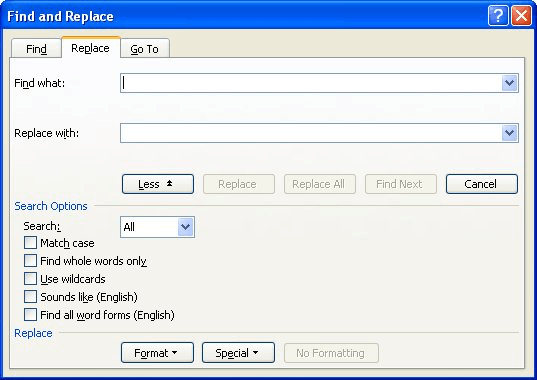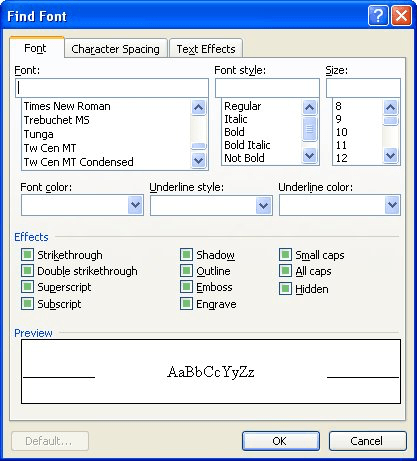Please Note: This article is written for users of the following Microsoft Word versions: 97, 2000, 2002, and 2003. If you are using a later version (Word 2007 or later), this tip may not work for you. For a version of this tip written specifically for later versions of Word, click here: Getting Rid of Hidden Text in Many Files.
Written by Allen Wyatt (last updated January 27, 2017)
This tip applies to Word 97, 2000, 2002, and 2003
Word allows you to apply many attributes to text. For instance, you can make text bold, italic, or underlined; these are all text attributes. Another attribute applicable to text is that it can be made hidden. Hidden text is often used for comments and other text not intended for inclusion in the final document.
Removing hidden text from a document is rather easy—just use Word's Find and Replace feature. You search for text with the hidden attribute turned on, and replace it with nothing, as is done in these steps:

Figure 1. The Replace tab of the Find and Replace dialog box.

Figure 2. The Find Font dialog box.
Lickety split, all the hidden text in the document is deleted. If you want to strip all the hidden text from a group of documents, then the only way to do it is with a macro. The macro basically needs to load each document, perform the replacements as detailed above, save the document, and close it. Any number of macros could be written to perform such a task (loading a document, processing it, and then saving it); some have been detailed in other issues of WordTips. If you need such a macro, consider this macro at the Word MVP Web site:
http://wordmvp.com/FAQs/MacrosVBA/BatchFR.htm
WordTips is your source for cost-effective Microsoft Word training. (Microsoft Word is the most popular word processing software in the world.) This tip (6398) applies to Microsoft Word 97, 2000, 2002, and 2003. You can find a version of this tip for the ribbon interface of Word (Word 2007 and later) here: Getting Rid of Hidden Text in Many Files.

The First and Last Word on Word! Bestselling For Dummies author Dan Gookin puts his usual fun and friendly candor back to work to show you how to navigate Word 2019. Spend more time working and less time trying to figure it all out! Check out Word 2019 For Dummies today!
Sometimes Word can get confused, and it may think that it needs to recover files that you are sure no longer exist. If ...
Discover MoreAfter using Word for a while, it is easy to accumulate quite a few documents. At some point you may want to make a change ...
Discover MoreWhen you start Word, it makes an assumption about where your documents are stored. If you want to force Word to change ...
Discover MoreFREE SERVICE: Get tips like this every week in WordTips, a free productivity newsletter. Enter your address and click "Subscribe."
There are currently no comments for this tip. (Be the first to leave your comment—just use the simple form above!)
Got a version of Word that uses the menu interface (Word 97, Word 2000, Word 2002, or Word 2003)? This site is for you! If you use a later version of Word, visit our WordTips site focusing on the ribbon interface.
Visit the WordTips channel on YouTube
FREE SERVICE: Get tips like this every week in WordTips, a free productivity newsletter. Enter your address and click "Subscribe."
Copyright © 2026 Sharon Parq Associates, Inc.
Comments